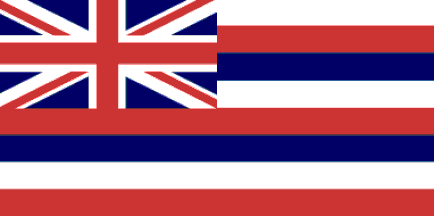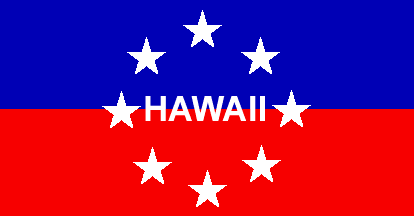 image by Mario Fabretto, 24 February 1998
image by Mario Fabretto, 24 February 1998

Last modified: 2006-07-08 by rick wyatt
Keywords: hawaii | united states | union jack |
Links: FOTW homepage |
search |
disclaimer and copyright |
write us |
mirrors
 image by Mario Fabretto, 24 February 1998
image by Mario Fabretto, 24 February 1998
See also:
In 1960, a star was added, representing Hawaii, bringing the total number of stars on the U.S. flag to 50. There are thirteen stripes representing the thirteen original colonies.
Hawaii Revised Statutes
Section 5-19. Description of the Hawaiian flag. The official description of the Hawaiian flag as authorized to represent the State of Hawaii on land and sea, and authorized for executive state agencies, second to the stars and
stripes of the United States shall be:
There is one difference between the regulations of 8 April 1896, and those in current use. The 1896 regulations call for a fimbriation to the Cross of St George of 1/6 the cross, whereas the modern ones ask for 1/3. Both sets call for "the arms of the red cross with border to be equal in width to one of the horizontal stripes", and whilst I interpreted the original to include the border and therefore, a total width of 1/8 the flag, I (along with FOTW and the official website) now interpret it to mean that the width of the red cross only should be 1/8 and the fimbriation extra (since to include a 1/3 fimbriation in the 1/8 would make an impossibly narrow cross and saltire.
Christopher Southworth, 29 July 2003
Chronology:
See also:
 image by Jaume Ollé, 7 April 1997
image by Jaume Ollé, 7 April 1997
According to NAVA news (January 1984) the flag of the governor of Hawaii is blue over red with the word "Hawaii" in white in the center and, around the word, 8 white stars (8 islands perhaps?).
Jaume Ollé, 7 April 1997
himil.gif) image by Joe McMillan, 21 April 2000
image by Joe McMillan, 21 April 2000
The state military crest, which is the crest used in the coats of arms of units of the National Guard, as granted by the precursor organizations of what is now the Army Institute of Heraldry. The official Institute of Heraldry blazon is "A dolphin embowed hauriant argent, in his mouth a key fesswise or."
Joe McMillan, 21 April 2000
Anyone familiar with the traditional heraldic depiction of a dolphin--as on the arms of the French Dauphins or the famous colophon of the Venetian printer Aldus Manutius--will be able to see at a glance that this is not an anatomically
correct dolphin, but it's a dolphin (the mammal), not a mahi-mahi (dolphinfish), the seafood delicacy. Neither does the creature on the crest and the U.S. Navy submariner's badge remotely resemble a mahi-mahi/dolphin-fish, which lacks the
snout of the heraldic (and natural) dolphin and has a single long dorsal fin extending the length of its back.
Joe McMillan, 8 April 2004